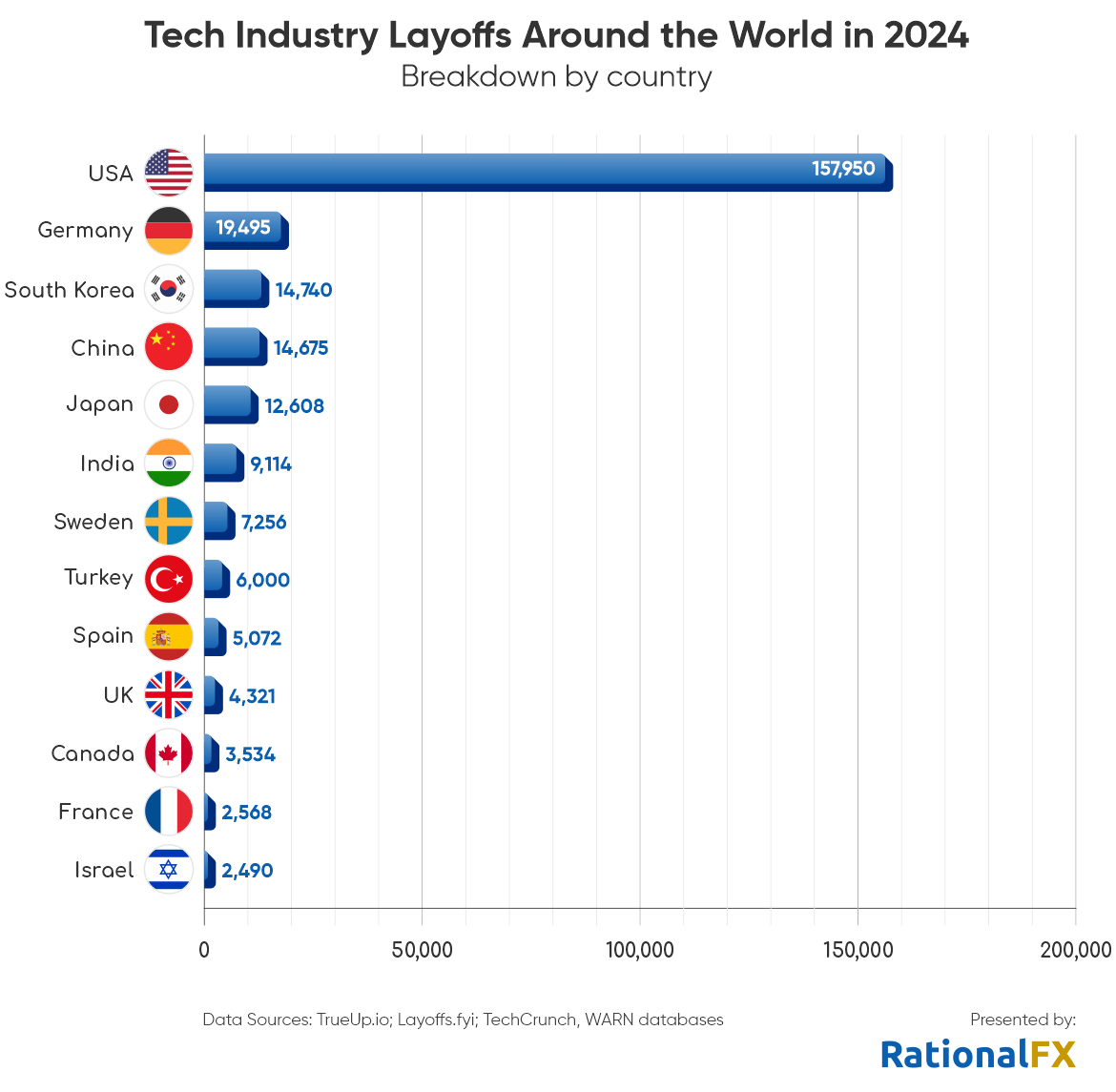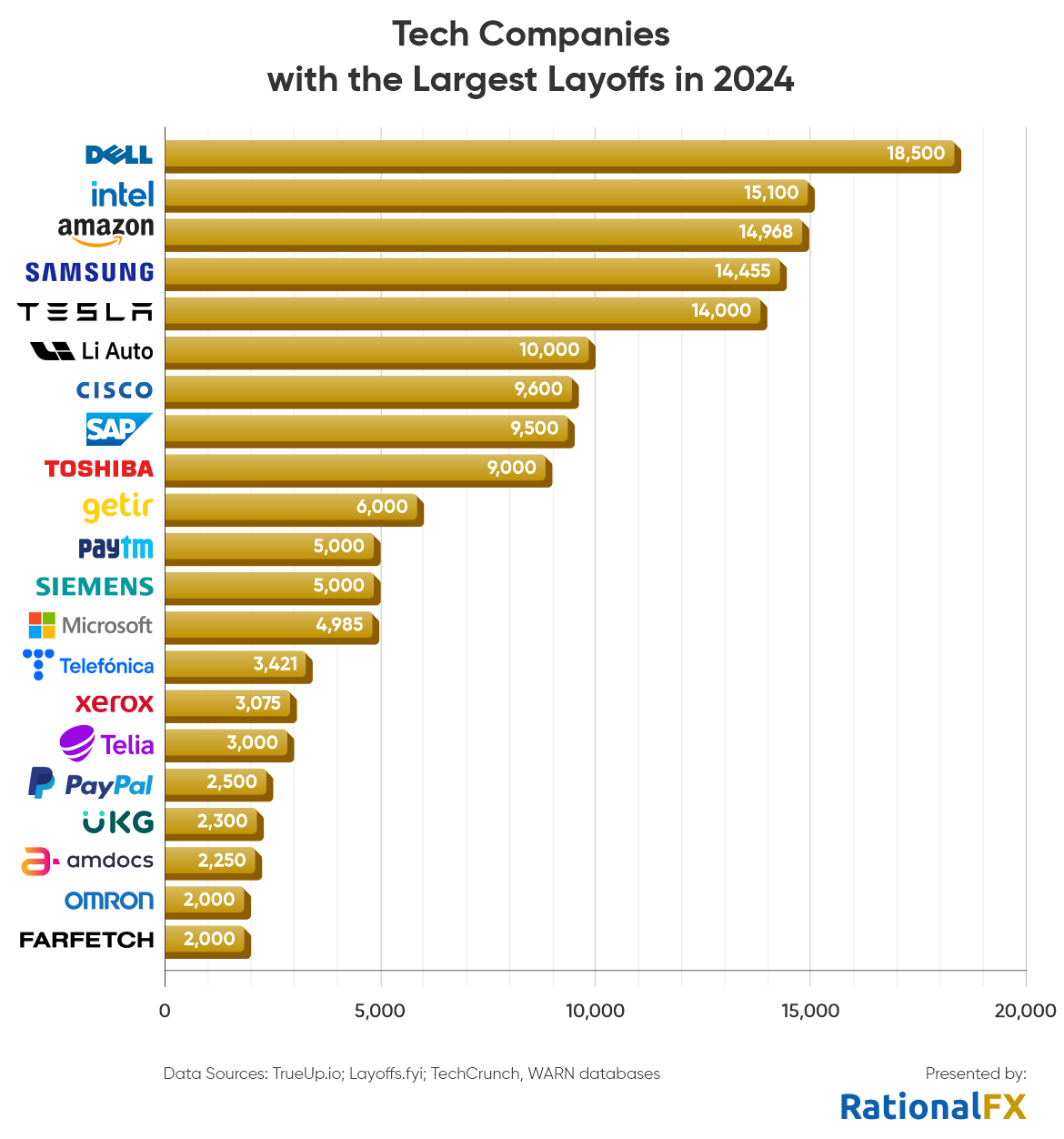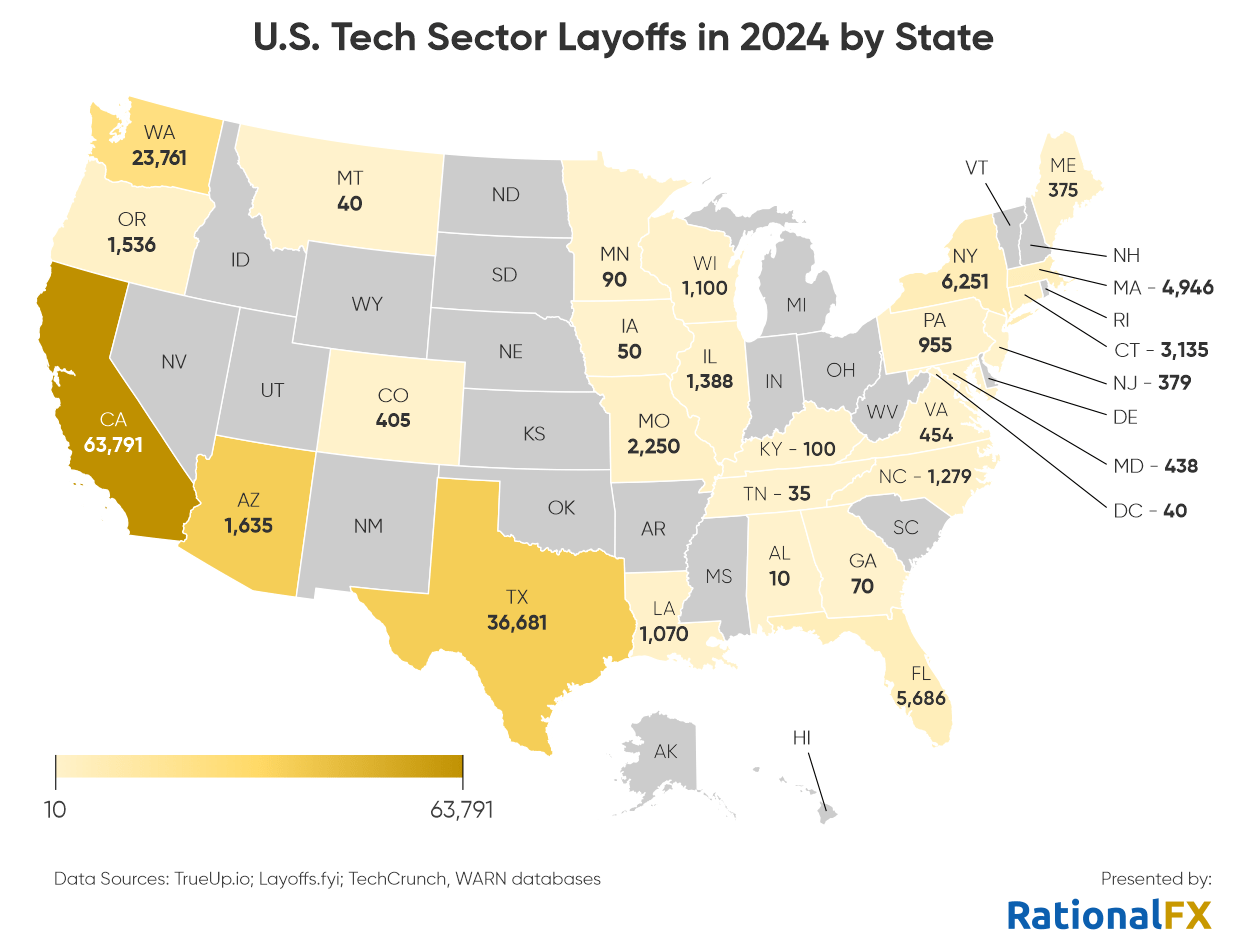The global tech sector experienced a turbulent year in 2024, with a staggering 280,991 employees losing their jobs as the industry wrestled with economic uncertainty and shifting market demands. Over half of these layoffs – 157,950 – were announced by U.S. companies, underscoring the country’s significant role in the ongoing workforce reductions. PC maker Dell led the way by cutting 18,500 positions, followed by Intel and Amazon, each eliminating approximately 15,000 jobs.
These figures reflect a broader trend of downsizing throughout the tech industry, driven by cost-cutting measures and a reassessment of priorities following years of rapid growth. The large-scale implementation of artificial intelligence tools has also been reshaping corporate structures, leading to the elimination of entire teams. The workforce crisis in big tech extends beyond a temporary correction; it has become the norm. This prompted the team at RationalFX to look into the wave of layoffs, researching the number of job cuts that occurred in 2024.
Based on figures from several sources, including TrueUp, TechCrunch, and Layoffs.fyi, we identified the companies that parted ways with a significant portion of their workforce. As the wave of layoffs in the tech industry continues into 2025, we also examined the redundancies since the beginning of the year. More than 10,000 employees in the technology sector have already lost their jobs. With no signs of slowing down, this wave will leave thousands more jobless, affecting not just talented individuals but entire communities currently relying on these (relatively high) salaries.

Considering the world’s largest tech corporations are U.S. companies, it is no wonder that more than half of all tech sector layoffs in 2024 were by U.S.-based businesses. It should also be noted that the most comprehensive data sources for job cuts are also based in the United States and are oriented towards mostly American and English-speaking audiences. The mass layoffs in countries such as China are also rarely covered by Western media as the information is difficult to confirm.
Even if layoffs in the United States are overrepresented, the numbers are still mind-boggling. Between January 1 and December 31 of 2024, 267 American tech companies have laid off a total of 157,950 employees. This accounts for more than half (56.2%) of all tech sector layoffs globally, which are 280,991. Of course, major economies such as China, India, Germany, South Korea, and Japan also lost a significant number of jobs in the technology industry; these layoffs, however, are dwarfed by the numbers in the U.S. as seen in the chart above.
Mass Layoffs at a Time of Growing Profits
The redundancies in the U.S., including in many Silicon Valley companies, are a result of over-hiring during the pandemic and high inflation. But there are other factors at play with recession fears and companies’ increased focus on AI being just two of them. Many companies have announced restructuring plans aiming to increase efficiency and profitability. Interestingly, 2023 and 2024 were extremely profitable for many businesses that reported increased revenues, record-high earnings for shareholders, and expansion to new markets.
Dell, for instance, saw its revenue grow on an annual basis for three consecutive quarters, with an increase of 9.51% in November 2024. Its gross profit, however, has shrunk between 2023 and 2024 by more than $1.8 billion. Amazon, on the other hand, performed well across the board: net sales grew by 11% to $158.9 billion in the third quarter of 2024, operating income increased by 55.6% to $17.4 billion, and net income grew by 55.2% to $15.3 billion ($1.43 per diluted share, up 52.1%). So, why are tech companies laying off people when they should be hiring?
In fact, new jobs are constantly being created and employees are being hired in the U.S. tech sector. There is a huge difference in the employment market and corporate strategies from twenty or ten years ago, however, with many of the positions now being temporary, gig-like jobs. And as companies shift to new technologies such as AI, certain jobs become redundant while new positions are opened.
In Germany, many of the layoffs have also been a result of restructuring efforts and focus on AI. In early 2024, Walldorf-based software giant SAP announced a restructuring program that would “prioritise strategic growth areas, including business AI”. However, the company has been criticised for masking significant job cuts under the euphemism “transformation program”. The exact number of eliminated positions is not clear but it is believed to be between 9,000 and 10,000. Not all employees were laid off, according to SAP, with some being offered “AI-centric” positions.
Another huge factor in Germany has been the economic stagnation with 2024 being the second year in a row of contraction in the economy. The manufacturing sector has fallen into a deep crisis due to rising electricity prices and declining external demand. This was reflected in last year’s layoffs in the tech sector, which almost reached 20 thousand. Along with SAP, other major companies to announce mass job cuts were tech giant Siemens (5,000 layoffs) and semiconductor manufacturer Infineon (1,400 layoffs).
Manufacturing Giants Lead in Tech Layoffs in 2024

In 2024, global tech layoffs surpassed 280,000, with the top 21 companies with the largest reductions slashing a combined 156,654 jobs. Leading the layoffs was Dell, which let go of 18,500 employees. Among the reasons for this cost-cutting measure is the declining demand for personal computers and enterprise hardware. Following closely, semiconductor giant Intel cut 15,100 positions amidst a downturn in chip sales and increased competition in the global semiconductor market.
The e-commerce titan Amazon also announced significant layoffs, cutting nearly 15,000 roles. These job reductions were part of the company’s ongoing restructuring, which began in late 2023 to streamline operations and adapt to changing consumer spending habits.
Electronics manufacturers weren’t immune, with Samsung laying off 14,455 employees, highlighting challenges in the global smartphone and appliance markets. Similarly, Toshiba cut 9,000 jobs as it restructured its struggling electronics and energy divisions. Germany’s manufacturer of everything from turbines and trains to healthcare tech and home appliances has also reduced its headcount by around 5,000. The positions are mostly in its factory automation business.
The electric vehicle (EV) sector also experienced layoffs, despite its growth potential. Industry leader Tesla laid off 14,000 employees as it sought to reduce operational costs amid increasing production expenses. Chinese EV maker Li Auto followed suit, cutting 10,000 jobs, reflecting broader challenges in the Chinese automotive market.
Software and tech service providers also contributed significantly to the workforce reduction. Cisco reduced its headcount by 9,600, while SAP let go of 9,500 employees. Even Microsoft, known for its robust cloud and software business, announced nearly 5,000 job cuts.
It seems manufacturing, be it electric vehicles, computers, or semiconductors has been hit particularly hard but layoffs were not confined to traditional tech companies. Turkish food delivery app Getir cut 6,000 jobs, illustrating the broader impact of economic headwinds on gig-economy businesses. Food and grocery delivery, in particular, grew immensely during the pandemic but have since been in a decline. In the spring of 2024, Getir confirmed its exit from the UK, Europe, and the United States to focus on its domestic market, a move which was followed by a restructuring that split the company into two separate entities. Similarly, fintech companies like Paytm and PayPal reduced their workforce by 5,000 and 2,500 positions, respectively, as funding slowed and profitability took centre stage.
California & Silicon Valley: A Tech Hub & Center of Job Cuts

As expected from the state’s high concentration of technological companies, California spearheaded layoffs in the U.S. tech sector last year, with 63,791 job cuts. These account for 40.4% of all tech layoffs in the country and were initiated by 127 companies, including Intel (15,100 layoffs), Cisco (9,600 layoffs), PayPal (2,500 layoffs), Unity (1,800 layoffs), Intuit (1,800 layoffs), Rivian (1,670 layoffs), Google (1,450 layoffs), and Broadcom (1,342 layoffs).
Nearly a quarter of all tech sector layoffs in the U.S., or 36,681 reductions, were announced by Texas-based companies. Among the companies that parted ways with the largest number of employees were Dell (18,500 layoffs), Tesla (14,000 layoffs), and Indeed (1,000 layoffs). Another 23,761 layoffs were conducted by companies from Washington State such as Amazon (14,968 layoffs), Microsoft (4,985 layoffs), and Expedia (1,500 layoffs).
Tech Sector’s Wave of Layoffs Continue into 2025
Looking at the latest company announcements, we can see the layoffs in Big Tech continue into 2025, albeit at a slower rate. Since the beginning of the year, at least 11,299 employees in the sector have lost their jobs, with the biggest reductions announced by Facebook’s parent company Meta. CEO Mark Zuckerberg announced the company is about to cut around 5% of its workforce or roughly 3,600 employees, focusing on “low performers”.
Performance-based layoffs were also announced by Microsoft, which is said to reduce its headcount by around 2,280. In an effort to streamline operations and reduce costs, Amazon said it would be eliminating a “small number of roles” in its communications department but it is believed the number of layoffs would be close to 2,000. Many of the companies that let go of employees in 2024 are now continuing to downsize in these fresh rounds of layoffs that will leave tens of thousands in the tech industry jobless over the coming months.
Methodology
For this report, the team at RationalFX examined well over a thousand layoff announcements from the technology sector, sourced from the IT job portal TrueUp.io, covering the period between January 1 and December 31, 2024. We also looked into the latest layoffs (as of January 30 2025) and searched through additional sources, including TechCrunch, Layoffs.fyi, and several WARN databases. These are publicly available announcements providing advance notice in cases of qualified plant closings and mass layoffs as required by the U.S. Worker Adjustment and Retraining Notification (WARN) Act.
Layoff figures were first aggregated at the company level to determine the total job cuts per firm. Next, companies were classified by their country of headquarters, providing insight into the geographic distribution of layoffs. To highlight the most significant workforce reductions, firms were ranked by the number of jobs eliminated, while countries were ranked based on the total layoffs reported by companies operating within them.
